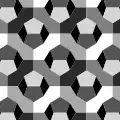Truncated pentahexagonal tiling
| Truncated pentahexagonal tiling | |
|---|---|
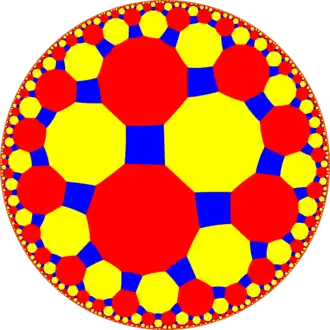 Poincaré disk model of the hyperbolic plane | |
| Type | Hyperbolic uniform tiling |
| Vertex configuration | 4.10.12 |
| Schläfli symbol | tr{6,5} or |
| Wythoff symbol | 2 6 5 | |
| Coxeter diagram | |
| Symmetry group | [6,5], (*652) |
| Dual | Order 5-6 kisrhombille |
| Properties | Vertex-transitive |
In geometry, the truncated tetrahexagonal tiling is a semiregular tiling of the hyperbolic plane. There are one square, one decagon, and one dodecagon on each vertex. It has Schläfli symbol of t0,1,2{6,5}. Its name is somewhat misleading: literal geometric truncation of pentahexagonal tiling produces rectangles instead of squares.
Dual tiling
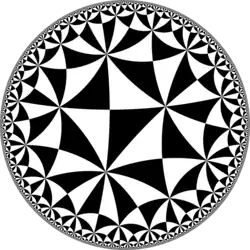
|
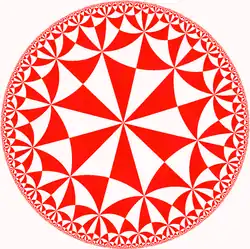
|
| The dual tiling is called an order-5-6 kisrhombille tiling, made as a complete bisection of the order-5 hexagonal tiling, here with triangles shown in alternating colors. This tiling represents the fundamental triangular domains of [6,5] (*652) symmetry. | |
Symmetry
There are four small index subgroup from [6,5] by mirror removal and alternation. In these images fundamental domains are alternately colored black and white, and mirrors exist on the boundaries between colors.
| Index | 1 | 2 | 6 | |
|---|---|---|---|---|
| Diagram | 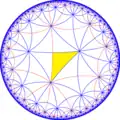
|
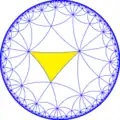
|
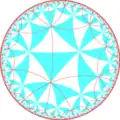
|
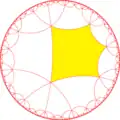
|
| Coxeter (orbifold) |
[6,5] = (*652) |
[1+,6,5] = (*553) |
[6,5+] = (5*3) |
[6,5*] = (*33333) |
| Direct subgroups | ||||
| Index | 2 | 4 | 12 | |
| Diagram | 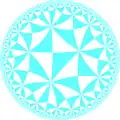
|
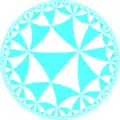
|
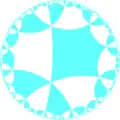
| |
| Coxeter (orbifold) |
[6,5]+ = (652) |
[6,5+]+ = (553) |
[6,5*]+ = (33333) | |
Related polyhedra and tilings
From a Wythoff construction there are fourteen hyperbolic uniform tilings that can be based from the regular order-5 hexagonal tiling.
Drawing the tiles colored as red on the original faces, yellow at the original vertices, and blue along the original edges, there are seven forms with full [6,5] symmetry, and three with subsymmetry.
| Uniform hexagonal/pentagonal tilings | |||||||||||
|---|---|---|---|---|---|---|---|---|---|---|---|
| Symmetry: [6,5], (*652) | [6,5]+, (652) | [6,5+], (5*3) | [1+,6,5], (*553) | ||||||||
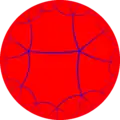
|
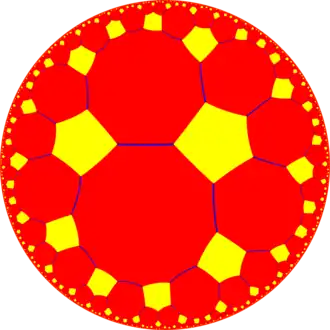
|
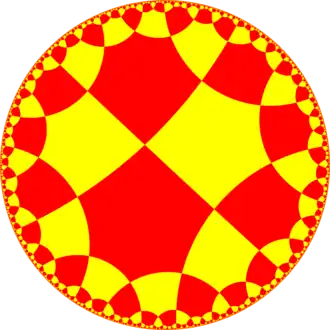
|
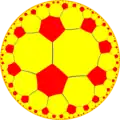
|
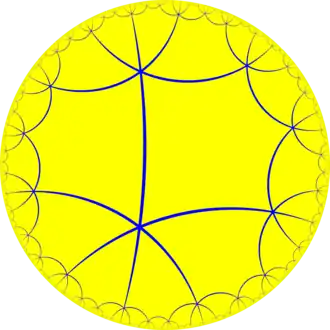
|
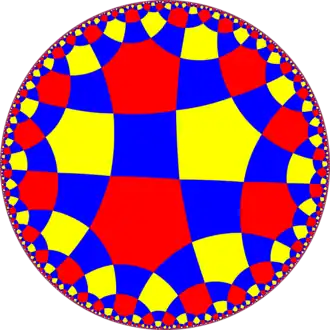
|

|
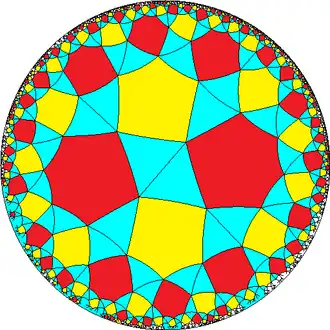
|

| |||
| {6,5} | t{6,5} | r{6,5} | 2t{6,5}=t{5,6} | 2r{6,5}={5,6} | rr{6,5} | sr{6,5} | s{5,6} | h{6,5} | |||
| Uniform duals | |||||||||||

|

|

|

|

|

|

|
|||||
| V65 | V5.12.12 | V5.6.5.6 | V6.10.10 | V56 | V4.5.4.6 | V4.10.12 | V3.3.5.3.6 | V3.3.3.5.3.5 | V(3.5)5 | ||
See also
References
- John H. Conway, Heidi Burgiel, Chaim Goodman-Strauss, The Symmetries of Things 2008, ISBN 978-1-56881-220-5 (Chapter 19, The Hyperbolic Archimedean Tessellations)
- "Chapter 10: Regular honeycombs in hyperbolic space". The Beauty of Geometry: Twelve Essays. Dover Publications. 1999. ISBN 0-486-40919-8. LCCN 99035678.

